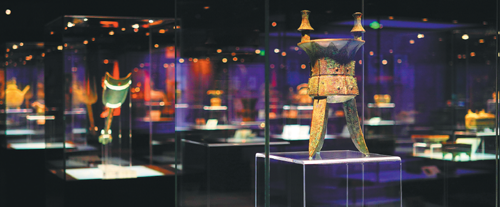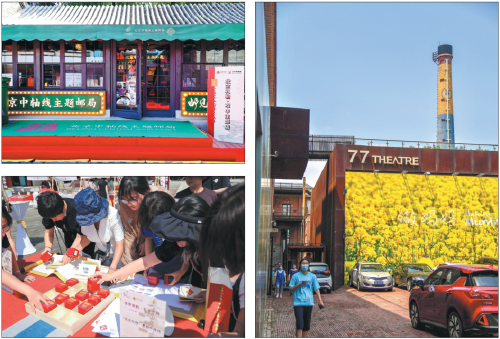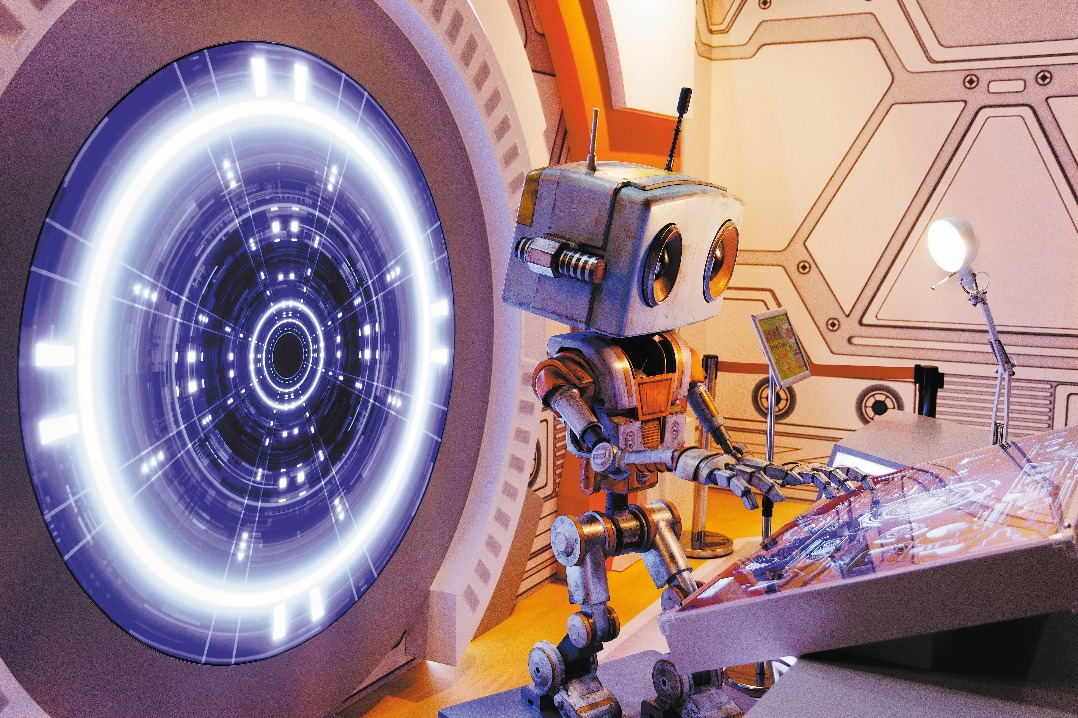Heritage provides blueprint for future
Diverse forms of new quality productive forces give Beijing's Dongcheng district a cutting edge in the cultural and creative sector, Cheng Yuezhu reports.

The hutong (alleyways) have long been iconic to central Beijing, promising those who enjoy taking a walk in tranquility a great experience, with their gray brick walls, upturned eaves and paths shaded by luxuriant tree branches.
But today, these hutong have more to offer. While most remain residential buildings, some courtyards have been renovated into areas for rich cultural and entertaining experiences.
Those who walk along the Doufuchi Hutong in Beijing's Dongcheng district may come across a small, inconspicuous door, but when they walk in, they find themselves in a courtyard of considerable size.
The courtyard, called The Guan, is now known as a local culture museum along the Beijing Central Axis, which was inscribed on the UNESCO World Heritage List this July.
Renovated from a former temple and opened to the public in January, The Guan includes a bookstore, a digital art gallery, a Beijing Central Axis Post Office, and a few hospitality venues.
A tourist surnamed Liu came across The Guan with her friend on a serendipitous afternoon "city-walk" session. She says that they wanted to wander around the Bell and Drum Towers area without making any additional plans, and this courtyard came as a pleasant surprise.
"When we walked in through the small door, I thought this place was like an unexpected realm. There's a bookstore, a Spanish poster exhibition in the digital gallery, and the restaurant looks quite nice as well. I think they are a good fusion of ancient and modern, and it's a nice place to walk around and rest," Liu says.
According to Chen Xue, curator of The Guan, the complex adopts diverse forms of new quality productive forces, including technological and innovative mediums, to highlight the culture of the Beijing Central Axis. New quality productive forces refer to advanced productivity freed from the traditional economic growth mode and productivity development paths. It features high tech, high efficiency and high quality, and comes in line with the new development philosophy.
"The inscription of the Beijing Central Axis on the UNESCO World Heritage List has had a significant impact, increasing public interest in our work and inspiring us to create new cultural scenarios. We've developed a consolidated showcase of the Beijing Central Axis-themed cultural and creative products, intangible cultural heritage elements and experiential cultural activities," Chen says.
The post office features a range of cultural merchandise themed on the Beijing Central Axis and Beijing culture. One of the best-selling products is the "Beijing Central Axis passport", a booklet that contains illustrations of the heritage site's 15 components, adopting anti-counterfeiting measures. Visitors to the post office can collect seal stamps in the booklet.
"When The Guan opened, it mainly attracted nearby residents, passing tourists and ancient architecture enthusiasts. After the inscription of the Beijing Central Axis, a lot of young people saw posts online and came to check it out, and tourists from home and abroad surged. The visitor numbers have doubled," she adds.
In response to the national call for "exploring effective mechanisms for the integration of culture and technology", authorities of the Dongcheng district have been leveraging its rich resources in recent years, promoting the high-quality development of the cultural industry and fostering new quality productive forces to boost the cultural market.
These approaches feature the combination of culture with other fields, such as technology, finance and consumption, empowering cultural and economic development through the revitalization of historical buildings, the leading examples of cultural enterprises and the upgrading of cultural industry parks.
Poly Culture Group, with its Beijing Poly Theatre and Poly Art Museum, also based in the district, has been exploring effective new methods of culture dissemination, cultural asset management and digitalization.
Its theaters have introduced a "smart theater" service platform that incorporates ticketing and big data analysis. For cultural artifact preservation and display purposes, the corporation developed a digital display cabinet that allows user interaction and naked-eye 3D technology for presenting key artifacts.
Ma Chi, general manager of Poly Culture Group's cultural communication digital technology center, introduces the digital display cabinet. While it appears to be an ordinary glass cabinet from the front, its sides are touch-sensitive screens that allow visitors to interact with the system.
A digital representation of an artifact is displayed on the screen and by simply tapping and dragging, visitors can rotate the object to view it from any angle to appreciate the artifact's details, such as inscriptions, and read about its history and background story.
One of the artifacts placed inside the cabinet is a bronze food vessel from around 2,900 years ago. Its lid is missing. Ma says that he and other digitalization experts worked with archaeological researchers to present the vessel and its history in digital format.
"By researching similar vessels, we digitally re-created a lid that's in line with historical facts. While no one knows where the lid is after several millennia, we can give viewers a concept of its complete form, which is something viewers wouldn't see from a traditional display case and without expert guidance," Ma says.
"Digital methods can better present artifacts before and after their restoration, as well as their history. In this way, the artifacts can be brought to life and visitors can gain a deeper understanding, recognize them and develop a sense of pride in our Chinese culture and history."
The 77 Cultural and Creative Park, also in Dongcheng district, exemplifies one of Beijing's urban renewal initiatives. Once an offset printing factory, it has been transformed into a cultural industry park centered on film, television and theater arts.
Industrial relics have been preserved, including a gigantic chimney now displaying real-time air quality and a hot foil stamping machine that stands as a witness to the park's industrial history. The former workshop in the middle of the park has been renovated into the 77 Theatre, a venue frequently hosting performing arts shows.
"The park is one of the earliest cultural and creative parks in Beijing, and one of the first to center on a particular theme, which in our case is film, television and theater," says Li Ming, deputy general manager of Beijing Dongfang Daopu Cultural Asset Operation and Management, the park's managing company. "Our park's positioning is compatible with Dongcheng district's cultural environment and resources."
The Central Academy of Drama and Beijing People's Art Theatre located in proximity provide rich performing arts resources and theater practitioners. The park's Beijing Drama Rehearsal Centre, with 18 rehearsal rooms and a studio, serves as a creative hub for many university and professional theater troupes. According to Li, more than 200 original theater productions are created and rehearsed here annually.
"Throughout the process of constructing and renovating the cultural park, we have not only given new purpose to the old buildings, but have also allowed the park to play a more profound role in Beijing's cultural landscape," Li says.


Today's Top News
- Chengdu games hailed as the new benchmark
- Xi, Lula pledge to deepen China-Brazil cooperation
- China, US reach deal to extend tariff suspension
- Demand for?Nvidia’s H20 chip lackluster
- Washington not incarnation of justice: China Daily editorial
- Tariff truce gains time for talks although some tough issues remain to be resolved






























